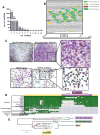A Primate lncRNA Mediates Notch Signaling during Neuronal Development by Sequestering miRNA
- PMID: 27263970
- PMCID: PMC4911262
- DOI: 10.1016/j.neuron.2016.05.005
A Primate lncRNA Mediates Notch Signaling during Neuronal Development by Sequestering miRNA
Abstract
Long non-coding RNAs (lncRNAs) are a diverse and poorly conserved category of transcripts that have expanded greatly in primates, particularly in the brain. We identified an lncRNA, which has acquired 16 microRNA response elements for miR-143-3p in the Catarrhini branch of primates. This lncRNA, termed LncND (neurodevelopment), is expressed in neural progenitor cells and then declines in neurons. Binding and release of miR-143-3p by LncND control the expression of Notch receptors. LncND expression is enriched in radial glia cells (RGCs) in the ventricular and subventricular zones of developing human brain. Downregulation in neuroblastoma cells reduced cell proliferation and induced neuronal differentiation, an effect phenocopied by miR-143-3p overexpression. Gain of function of LncND in developing mouse cortex led to an expansion of PAX6+ RGCs. These findings support a role for LncND in miRNA-mediated regulation of Notch signaling within the neural progenitor pool in primates that may have contributed to the expansion of cerebral cortex.
Copyright © 2016 Elsevier Inc. All rights reserved.
Conflict of interest statement
The authors declare no competing financial interests.
Figures







Comment in
-
Junk DNA Used in Cerebral Cortical Evolution.Neuron. 2016 Jun 15;90(6):1141-1143. doi: 10.1016/j.neuron.2016.06.007. Neuron. 2016. PMID: 27311076
References
-
- Amaral PP, Mattick JS. Noncoding RNA in development. Mamm Genome. 2008;19:454–492. - PubMed
-
- Artavanis-Tsakonas S. Notch Signaling: Cell Fate Control and Signal Integration in Development. Science (80- ) 1999;284:770–776. - PubMed
-
- Barry G, Mattick JS. The role of regulatory RNA in cognitive evolution. Trends Cogn Sci. 2012;16:497–503. - PubMed
Publication types
MeSH terms
Substances
Grants and funding
LinkOut - more resources
Full Text Sources
Other Literature Sources
Molecular Biology Databases

